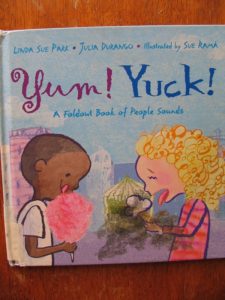By Linda Sue Park/Julia Durango, Illustrated by Sue Rama (Charles bridge – Watertown, MA in 2005)
Presenting people’s different sound in unexpected situation as comparing several languages. One the inner pages, the English translation is revealed along with illustration to describe the situation. With demonstration by a native speaker of each language, will be more helpful usage of this book.

人間がとっさの時に発する音を、様々な言語で表わしているユニークな絵本。美味しい時、まずい時、驚いた時、嬉しい時等々に思わず口から出る音を、世界の言葉とこどものイラストで表現している。各言葉の見開きページには、その言葉が発せられた状況を描き、英語の表現がある。ページ毎に読者が言葉の音を読んで発し、4人の子ども達の表現からそのページの言葉の意味を推測するのも、面白いこの絵本の使い方となる。答えの確認は、同じページの見開きページで出来る。実際の音は、その言葉を母国語とする人を招いて聞くことが出来れば、更にこの絵本の効果が上がりそうである。









